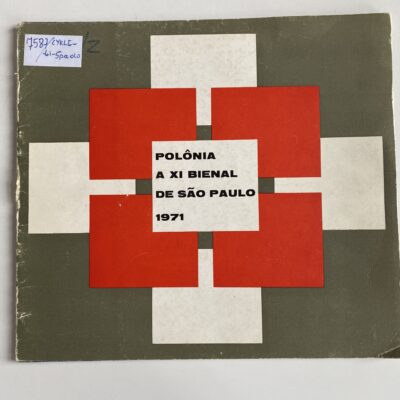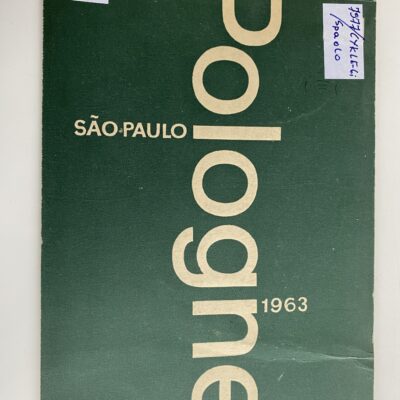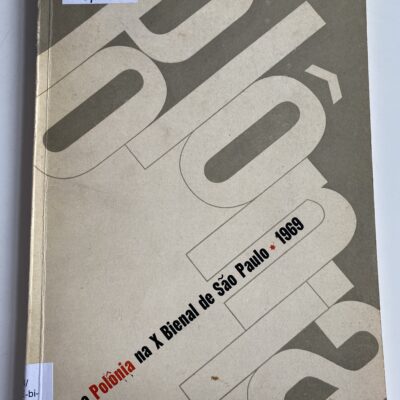Polish Women Artists at the Sao Paulo Biennale
Author: Wiktoria Szczupacka
At the time of this blog post is being written, the XXXV edition of the Sao Paulo Biennale is currently taking place. Unfortunately, I cannot spot a single Polish name on the list of artists. This is a pity, because for years this event has been an important bridge between Poland and South America.
The Sao Paulo Biennial was first held in 1951, on the initiative of Ciccillo Matarazzo, a Brazilian industrialist of Italian origin. The Sao Paulo Biennale was meant to correspond with, but also provide an alternative to, the famous Venice event. As it was presented the aim of the exhibition was originally to familiarize the Brazilian public with contemporary art (especially Western European and American art), to enable provincial artists to make their debut on the national stage and to make the city of São Paulo an international centre for art.
For communist Poland, participation in this event was particularly important. It demonstrated their political influences and sympathies, but also allowed Poles to learn about culture and art from Brazil.
Polish exhibitions were prepared by directors of state institutions, such as Ryszard Stanisławski and Mariusz Hermansdorfer. These shows covered various fields of art: painting, graphics, design and the like. There were presentations in which many artists were invited, and there were also those in which a few or only one artist was exhibited.
In terms of gender parity, there were not many women included in the presentations, but in the biographies of two female artists, participation in the Sao Paulo Biennale was regarded as a crucial moment in their careers.
I am referring to Maria Anto and Magdalena Abakanowicz. Both gained international recognition through this Biennale: Maria Anto, as a surrealist. primitivist painter, and Magdalena Abakanowicz, as a textile artist.
The title of this blog post is inspired by the book Poles at the Venice Biennale. And here, I have decided to present the connections and meetings during the communist period. Not only as an important element of international cultural policy, but as an art history of the institution of Sao Paulo Biennale. However, beyond the significant moment in the biographies of the two well-known polish female artists, I cannot tell if this biennial inspired any other important artistic contact, such as a mutual interest between LA and CEE?
I leave this question open and give the list of the participating artists from the People’s Republic of Poland in the Sao Paulo Biennale.
- Catalogue covers of Polish exhibitions at the Sao Paulo Biennale
- Catalogue covers of Polish exhibitions at the Sao Paulo Biennale
- Catalogue covers of Polish exhibitions at the Sao Paulo Biennale
- Catalogue covers of Polish exhibitions at the Sao Paulo Biennale
- Catalogue covers of Polish exhibitions at the Sao Paulo Biennale
- Catalogue covers of Polish exhibitions at the Sao Paulo Biennale
- Catalogue covers of Polish exhibitions at the Sao Paulo Biennale
- Catalogue covers of Polish exhibitions at the Sao Paulo Biennale
- Catalogue covers of Polish exhibitions at the Sao Paulo Biennale
- Catalogue covers of Polish exhibitions at the Sao Paulo Biennale
- Catalogue covers of Polish exhibitions at the Sao Paulo Biennale
- Catalogue covers of Polish exhibitions at the Sao Paulo Biennale
- Catalogue covers of Polish exhibitions at the Sao Paulo Biennale
- Catalogue covers of Polish exhibitions at the Sao Paulo Biennale
1951 (I)
1953 (II)
1955 (III)
1957 (IV)
1959 (V) – Jan Cybis, Tadeusz Brzozowski, Stefan Gierowski, Aleksander Kobzdej, Jan Lebensztejn, Jerzy Nowozielski, Jerzy Tchórzewski;
1961 (VI) – Maria Jarema, Tadeusz Kulisiewicz, Halina Chrostowska, Józef Gielniak, Lucjan, Mianowski, Jerzy Panek, Stefan Suberlak, Mieczysław Wejman, Stanisław Wójtowicz;
1963 (VII) – Maria Anto, Eugeniusz Markowski, Rajmund Pietkiewicz, Bronisław Wojciech Linke, Zbigniew Makowski, Marian Malina, Konrad Srzednicki;
1965 (VIII) – Kiejstut Bereźnicki, Zbigniew Gostomski, Władysław Hasior, Jan Tarasin, Tadeusz Jackowski, Janina Kraupe, Andrzej Pietsch, Nikifor, Magdalena Abakanowicz, Jolanta Owidzka, Wojciech Sadley;
1967 (IX) – Tadeusz Kantor, Jerzy Krawczyk, Włodzimierz Kunz, Lucjan Mianowski, Jerzy Bereś, Jerzy Jarnuszkiewicz;
1969 (X) – Jacek Malczewski; Stanisław Fijałkowski, Kazimierz Mikulski, Ryszard Winiarski, Andrzej Strumiłło, Danuta Kluza, Roman Opałka, Grzegorz Kowalski; Waldemar Świerzy;
1971(XI) – Władysław Hasior, Wojciech Sadley, Janusz Przybylski, Jan Dobkowski;
1973 (XII) – Teofil Ociepka, Franciszek Starowiejski;
1975 (XIII) – Tadeusz Brzozowski;
1977 (XIV) – Józef Łukomski, Roman Opałka, Grupa architektoniczna „Mass” (Zbigniew Gądek, Ewa Szymańska);
1979 (XV) – Zbigniew Dłubak, Natalia LL, Andrzej Lachowicz, Józef Szajna, Grzegorz Sztabiński;
1981 (XVI) – Karol Broniatowski;
1983 (XVII) – Andrzej Matuszewski, Andrzej Szewczyk, Grzegorz Sztabiński, Izabela Gustowska, Jan Dobkowski, Jan Jaromir Aleksiun, Jan Lebenstein, Stanisław Fijałkowski, Zdzisław Jurkiewicz, Zbigniew Makowski;
1985 (XVIII) – (Absence of representation from Poland, due to internal conflicts between artistic communities);
1987 (XIX) – Tomasz Ciecierski, Edward Dwurnik, Izabela Gustowska, Teresa Miszkin, Leon Tarasewicz;
1989 – (XX) – Anna Bohdziewicz, Stanisław Kulawiak, Zdzisław Pacholski, Krzysztof Pawela, Krzysztof Pruszkowski, Zofia Rydet, Zygmunt Rytka;


















